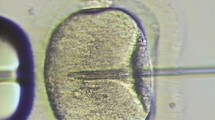Abstract
Purpose
The present research was undertaken to study probable genetic variations of MOV10L1 in 30 infertile men that had complete maturation arrest in their spermatocyte levels and 70 fertile men as the control group.
Methods
We performed polymerase chain reaction single strand conformation polymorphism (PCR-SSCP) on extracted DNAs and sequencing was used to confirm the results. Identified polymorphisms in the MOV10L1 were further subjected to a haplotype analysis.
Results
We identified eight single nucleotide polymorphisms (SNPs): one missense (rs2272837) and four nonsense polymorphisms (rs2272836, rs11704548, rs2272838, rs138271) in the exonic sequences and three polymorphisms (rs12170772, rs2272840, rs17248147) in the intronic regions. With the exception of rs2272838, there was a statistically significant association in all polymorphisms between study population (P < 0.05). The result of haplotyping analysis showed ten possible haplotypes, from which five were significantly increased in infertile patients compared with the control group.
Conclusions
Our results suggest that MOV10L1 gene polymorphisms in the studied infertile males with complete maturation arrest are linked to infertility.


Similar content being viewed by others
References
de Kretser DM. Male infertility. Lancet. 1997;349:787–90.
Matzuk MM, Lamb DJ. Genetic dissection of mammalian fertility pathways. Nat Cell Biol. 2002;4(Suppl):s41–9.
Matzuk MM, Lamb DJ. The biology of infertility: research advances and clinical challenges. Nat Med. 2008;14:1197–213.
Poongothai J, Gopenath TS, Manonayaki S. Genetics of human male infertility. Singap Med J. 2009;50:336–47.
Wang PJ, McCarrey JR, Yang F, Page DC. An abundance of X-linked genes expressed in spermatogonia. Nat Genet. 2001;27:422–6.
Frost RJ, Hamra FK, Richardson JA, Qi X, Bassel-Duby, et al. MOV10L1 is necessary for protection of spermatocytes against retrotransposons by Piwi-interacting RNAs. Proc Natl Acad Sci U S A. 2010;107:11847–52.
Ueyama T, Kasahara H, Ishiwata T, Yamasaki N, Izumo S. Csm, a cardiac-specific isoform of the RNA helicase Mov10l1, is regulated by Nkx2.5 in embryonic heart. J Biol Chem. 2003;278:28750–7.
Liu ZP, Nakagawa O, Nakagawa M, Yanagisawa H, Passier R, et al. CHAMP, a novel cardiac-specific helicase regulated by MEF2C. Dev Biol. 2001;234:497–509.
Liu ZP, Olson EN. Suppression of proliferation and cardiomyocyte hypertrophy by CHAMP, a cardiac-specific RNA helicase. Proc Natl Acad Sci U S A. 2002;99:2043–8.
Zheng K, Xiol J, Reuter M, Eckardt S, Leu NA, et al. Mouse MOV10L1 associates with Piwi proteins and is an essential component of the Piwi-interacting RNA (piRNA) pathway. Proc Natl Acad Sci U S A. 2010;107:11841–6.
Kuramochi-Miyagawa S, Watanabe T, Gotoh K, Totoki Y, Toyoda A, et al. DNA methylation of retrotransposon genes is regulated by Piwi family members MILI and MIWI2 in murine fetal testes. Genes Dev. 2008;22:908–17.
Cordaux R, Batzer MA. The impact of retrotransposons on human genome evolution. Nat Rev Genet. 2009;10:691–703.
Aravin AA, Hannon GJ. Small RNA silencing pathways in germ and stem cells. Cold Spring Harb Symp Quant Biol. 2008;73:283–90.
Ghildiyal M, Zamore PD. Small silencing RNAs: an expanding universe. Nat Rev Genet. 2009;10:94–108.
Kim VN, Han J, Siomi MC. Biogenesis of small RNAs in animals. Nat Rev Mol Cell Biol. 2009;10:126–39.
Malone CD, Hannon GJ. Small RNAs as guardians of the genome. Cell. 2009;136:656–68.
Thomson T, Lin H. The biogenesis and function of PIWI proteins and piRNAs: progress and prospect. Annu Rev Cell Dev Biol. 2009;25:355–76.
Kuramochi-Miyagawa S, Matsuda Y, Nakano T. Mili, a mammalian member of piwi family gene, is essential for spermatogenesis. Development. 2004;131:839–49.
Aravin A, Gaidatzis D, Pfeffer S, Lagos-Quintana M, Landgraf P, et al. A novel class of small RNAs bind to MILI protein in mouse testes. Nature. 2006;442:203–7.
Kuramochi-Miyagawa S, Kimura T, Yomogida K, Kuroiwa A, Tadokoro Y, et al. Two mouse piwi-related genes: miwi and mili. Mech Dev. 2001;108:121–33.
Singh M, Singh P, Juneja PK, Singh S, Kaur T. SNP-SNP interactions within APOE gene influence plasma lipids in postmenopausal osteoporosis. Rheumatol Int. 2011;31:421–3.
Acknowledgments
We thank the study participants for their participation in this study. We are grateful to Dr. M. Akhond and Dr. M. shamsipour for statistical analyses. This thesis was supported by a grant provided by Royan Institute.
Author information
Authors and Affiliations
Corresponding author
Additional information
Capsule Genetic disruption of MOV10L1 gene in a mouse model halts spermatogenesis during meiosis I causing azoospermia due to complete meiotic arrest. Therefore, it is expected that this gene may also play a role in human male infertility. We identified eight SNPs in the infertile men that had complete maturation arrest in their spermatocytes. The result of haplotyping analysis showed ten possible haplotypes, from which five were significantly increased in infertile patients compared with the control population.
Rights and permissions
About this article
Cite this article
Sarkardeh, H., Totonchi, M., Asadpour, O. et al. Association of MOV10L1 gene polymorphisms and male infertility in azoospermic men with complete maturation arrest. J Assist Reprod Genet 31, 865–871 (2014). https://doi.org/10.1007/s10815-014-0240-1
Received:
Accepted:
Published:
Issue Date:
DOI: https://doi.org/10.1007/s10815-014-0240-1




